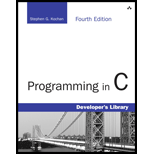
Type in and run the
Program Plan:
- Include the required headers.
- Define the structure
- Define the main method
- Declare the required variables.
- Condition to validate the arguments that are passed.
- Based on the condition that are is specified, proper resultant is being displayed.
The program is used to copy the contents of the text file 1 to the text file 2 by passing the arguments as the commands.
Explanation of Solution
//include the necessary headers
#include<stdio.h>
#include<stdlib.h>
//main method
int main(int argc,char *argv[])
{
//declare the required variables
FILE *in,*out;
int c;
//condition to validate the arguments that are passed
if(argc!=3)
{
//prompt user to enter the files
fprintf(stderr,"Need two files names\n");
//return the value
return 1;
}
//condition to validate the arguments that are passed
if((in=fopen (argv[1],"r"))==NULL)
{
//prompts the user that the file cannot be read
fprintf(stderr,"can't read %s.\n",argv[1]);
//return
return 2;
}
//condition to validate the arguments present
if((out = fopen(argv[2],"w"))==NULL)
{
//prompts user about the write error
fprintf(stderr,"can't write %s.\n",argv[2]);
//return value
return 3;
}
//loop that iterates for the end of file
while((c=getc(in))!=EOF)
//write the contents
putc(c,out);
//display file has been copied
printf("File has been copied.\n");
//close the file
fclose(in);
//close the file
fclose(out);
//return 0
return 0;
}
File has been copied.
- The above code is executed by passing the test file in the form of commands.
- Type the following for making the code to run:
Main.c test.txt test1.txt
test.txt:
Programming is fun
test1.txt:
Programming is fun
After executing bove commands the contents of the “test.txt” is being copied to “test1.txt” as shown above.
Want to see more full solutions like this?
Chapter 16 Solutions
Programming in C
Additional Engineering Textbook Solutions
Thinking Like an Engineer: An Active Learning Approach (4th Edition)
Starting Out with Python (4th Edition)
Computer Science: An Overview (13th Edition) (What's New in Computer Science)
Starting Out with C++: Early Objects (9th Edition)
Introduction To Programming Using Visual Basic (11th Edition)
- Ensure you answer the question asked at the end of the document. Do not just paste things without the GNS3 console outputsarrow_forward"Do not use AI tools. Solve the problem by hand on paper only and upload a photo of your handwritten solution."arrow_forward"Do not use AI tools. Solve the problem by hand on paper only and upload a photo of your handwritten solution."arrow_forward
- "Do not use AI tools. Solve the problem by hand on paper only and upload a photo of your handwritten solution."arrow_forward"Do not use AI tools. Solve the problem by hand on paper only and upload a photo of your handwritten solution."arrow_forwardSolve this "Do not use AI tools. Solve the problem by hand on paper only and upload a photo of your handwritten solution."arrow_forward
- "Do not use AI tools. Solve the problem by hand on paper only and upload a photo of your handwritten solution."arrow_forward"Do not use AI tools. Solve the problem by hand on paper only and upload a photo of your handwritten solution."arrow_forwardSpecifications: Part-1Part-1: DescriptionIn this part of the lab you will build a single operation ALU. This ALU will implement a bitwise left rotation. Forthis lab assignment you are not allowed to use Digital's Arithmetic components.IF YOU ARE FOUND USING THEM, YOU WILL RECEIVE A ZERO FOR LAB2!The ALU you will be implementing consists of two 4-bit inputs (named inA and inB) and one 4-bit output (named out). Your ALU must rotate the bits in inA by the amount given by inB (i.e. 0-15).Part-1: User InterfaceYou are provided an interface file lab2_part1.dig; start Part-1 from this file.NOTE: You are not permitted to edit the content inside the dotted lines rectangle. Part-1: ExampleIn the figure above, the input values that we have selected to test are inA = {inA_3, inA_2, inA_1, inA_0} = {0, 1, 0,0} and inB = {inB_3, inB_2, inB_1, inB_0} = {0, 0, 1, 0}. Therefore, we must rotate the bus 0100 bitwise left by00102, or 2 in base 10, to get {0, 0, 0, 1}. Please note that a rotation left is…arrow_forward
 C++ for Engineers and ScientistsComputer ScienceISBN:9781133187844Author:Bronson, Gary J.Publisher:Course Technology Ptr
C++ for Engineers and ScientistsComputer ScienceISBN:9781133187844Author:Bronson, Gary J.Publisher:Course Technology Ptr Programming with Microsoft Visual Basic 2017Computer ScienceISBN:9781337102124Author:Diane ZakPublisher:Cengage Learning
Programming with Microsoft Visual Basic 2017Computer ScienceISBN:9781337102124Author:Diane ZakPublisher:Cengage Learning Microsoft Visual C#Computer ScienceISBN:9781337102100Author:Joyce, Farrell.Publisher:Cengage Learning,COMPREHENSIVE MICROSOFT OFFICE 365 EXCEComputer ScienceISBN:9780357392676Author:FREUND, StevenPublisher:CENGAGE LProgramming Logic & Design ComprehensiveComputer ScienceISBN:9781337669405Author:FARRELLPublisher:Cengage
Microsoft Visual C#Computer ScienceISBN:9781337102100Author:Joyce, Farrell.Publisher:Cengage Learning,COMPREHENSIVE MICROSOFT OFFICE 365 EXCEComputer ScienceISBN:9780357392676Author:FREUND, StevenPublisher:CENGAGE LProgramming Logic & Design ComprehensiveComputer ScienceISBN:9781337669405Author:FARRELLPublisher:Cengage





